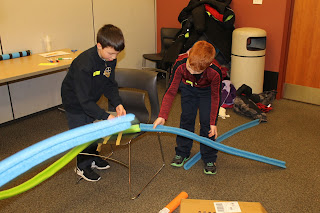Roller Coaster Challenge
Who doesn't love a good roller coaster? In STEAM we learned the Science is one of Newton's Laws of Motion that says that an object in motions will stay in motion and an object at rest will stay at rest. Gravity also makes this work. This is a fun project that kids will love and can learn some science!
Check out these tips of the trade
Experiment:
Requirements: Must have a large hill, a
loop, a bump, and a curve.
Step 1: Materials
Pool noodles cut in half
Include elements from around the house, like tables, chairs, cups, etc.
You'll need about 4 half-tubes per child.
Step 2: Starting a Roller Coaster
Let kids know that the higher the roller coaster is when it starts, the more energy the marble will have when it begins rolling. More energy means the marble will be able to travel farther and faster.
Step 3: Connecting Track Pieces
Emphasize that no matter how awesome the roller coaster looks, if the connections are
sloppy, it won't work well.
Most of the time roller coasters will need to touch down onto a flat surface like the floor. To secure the tubing to the floor, use two smaller pieces of tape and secure the sides of the roller coaster. Do not tape across the entire tube. Leaving the track clear of tape helps ensure that the marble will roll smoothly.
Centripetal force is like momentum: it's when
an object wants to keep moving forward
except that it's forced into a circular path.
negative effects of momentum. If the hill is too small and the marble is travelling too fast, the marble's momentum will carry it up the hill and then continue its trajectory off the track.
Learning objective:
- Students will comprehend basic physics concepts that are applicable to roller coaster construction, including potential energy, kinetic energy, and momentum.
- Through a cycle of building, testing, observing and revision, students will gain an experiential understanding of fundamental physics concepts and the basics of successful roller coaster construction





